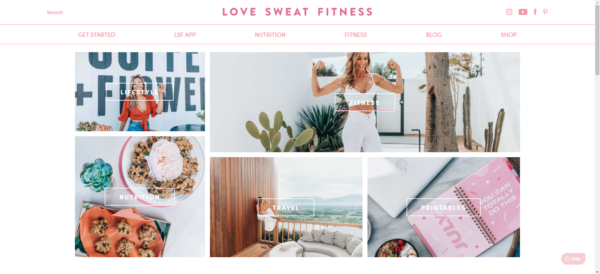
Think of how much time you’ve spent learning about health and fitness. You’re the expert in this industry and you probably get questions all the time from people in your life. If only there was a way to help teach people about health and fitness and make money doing it.
If this idea interests you, you may want to start a fitness blog. It’s a way to broadcast your message to the world, help your readers, and turn a profit as well.
In this guide, we’ll review how to start a fitness blog, why a blog is a great idea, and some tips to help you find success.
Ready to find more customers and get expert fitness marketing advice, all in one place?
What is a fitness blog?
A fitness blog is a place where you can put together written content that revolves around being fit. In most cases, the blog is run by a fitness expert who has knowledge they want to share with people.
These posts aren’t personal diary entries — they’re aimed to teach, entertain, and influence the reader. The overall idea of your blog can be very similar to a fitness Instagram account. Different blogs will accomplish different things. In general, the person writing the blog is trying to make extra money and help their readers.
Blogs are a great way to make money as a side job or a full-time business. Fitness blogs, specifically, are a good place to promote your services as a fitness instructor, nutritionist, or sell your fitness equipment.
The importance of a fitness blog
People often struggle when it comes to health and fitness. This is why a fitness blog is so important. If you put together a high-quality blog, people can start learning how to take care of their bodies.
At the same time, you have an opportunity to share your knowledge and make money doing it. Even if you’re busy running a studio or gym, you can increase your revenue by starting a blog.

How to start a fitness blog: step-by-step instructions
The process of starting a blog is really easy. The hard part is keeping up with it and eventually making money from it. If you understand how to market your fitness blog, it can turn into a lucrative hustle.
When it comes to starting the blog, it can be done within a few minutes. There are four simple steps to follow before you have your blog.
1. Find your specialty
The niche of “health and wellness” might seem like enough, but you’ll want to get more specific if you’re going to find success. Your specialty will ultimately determine the niche you’ll be writing in — after all, you want to write about a subject you know well. The topic should be one that you can shed some insight into.
If you went through a massive weight loss journey or that’s your specialty with your clients, that’s a great place to start. Starting a fitness blog about losing weight might be your focus.
The way to find your specialty is through a little self-analyzation. What subtopic within health and wellness are you well-versed in?
2. Pick the perfect name
Now that you know your specialty, it’s time for a great name. If this blog is working in tandem with your fitness services, you might use the same name. For example, Planet Fitness has a blog under the same name as their gym.
If you are a fitness nut with no business to drive readers to, this step is all about picking the right name. It’s okay to have fun in this step. Using a play on words will help you stand apart.
The name should somehow tie to your blog. “Workout Mommy” might be the right name for someone whose content revolves around balancing fitness and being a mom. Try to keep the name relatively short, so it can easily pop up on Google and it’s easy to remember.
To summarize, a great name for your blog should be:
- Short
- Funny
- Easy to remember
- Simple to pronounce
- Related to your specialty
3. Choose the right platform
If you didn’t know, your blogs have to use a professional platform and host. These companies will make sure your content gets posted to the internet and isn’t just living on your personal computer.
A good platform will let you customize your blog and have plenty of freedom. A platform like Constant Contact is the preferred option for many people. They help you build your website from scratch using drag-and-drop customization, and they’ll host your website.
Constant Contact also offers built-in SEO right in their website platform (more on SEO in a second). Use the AI builder to save some time and get your fitness blog up and running.
4. Start writing
With everything else set up, now it’s time to start writing. You can type your content right into a draft on your chosen platform, use Google Docs or Microsoft Word.
You don’t need to be a professional writer to write a blog. Readers are more concerned with getting expert advice from a fitness professional. You can type all the content on your own and publish it directly to your blog.
Tips for running a successful fitness blog
Knowing how to start a fitness blog is just the start. In this section, we’ll outline some tips that can make your blog successful. Keep these in mind as you move forward.
Be consistent
Consistency might be the most important part of your blog. This refers to a few different things:
- How often you post. Posting a few times a week might help you reach a larger audience. It builds a stronger presence on Google and increases your chances of being seen.
- When you post. You can time when your blogs are posted to your site. People can subscribe to your blog and get notified when a new post goes up. For that reason, you should avoid posting too late or early.
- The type of content you publish. All of your content should fall in the same category. If you randomly post an article about NASA’s new mission, your readers will get confused and might unsubscribe. This doesn’t mean that all of your blogs have to be “how-tos”, but all of your posts should fall inside the same subcategory of health and wellness.
- Your tone and voice. It might take you some time to establish a solid tone. When it comes to fitness branding, it’s very important to keep your tone from post to post. Otherwise, readers won’t know what to expect when they go to the next blog post.
Don’t forget what sets you apart
Your niche is the driving force behind your blog. Specifically, your industry knowledge within the niche is what makes you unique.
As long as you keep that in mind as you’re writing a post, you’ll have a better chance of running a successful blog.
People want fitness and health advice from experts. A blog is a great medium to deliver this advice to people.
Remember your target audience
Your writing style and terminology should be aligned with your target audience. Using jargon and complicated terms from the fitness world won’t translate well for a beginners’ audience.
Your blog content should be interesting for people within your audience. It should touch on topics that are meaningful.
Use SEO best practices
A blog is one of the best places for SEO to take place. SEO stands for Search Engine Optimization. It refers to tactics and techniques that help your website show up on Google results pages.
- Keywords. Keywords are certain phrases or words that searchers might lookup in Google to find you. “Best workout for moms” is an example of a keyphrase. You can build a blog article around this single topic. When people search this term, the hope is that your page shows up towards the top of the results.
- Keep the content highly readable. If your content is easy to read, Google will “reward” you with a higher rank. Just write the blog posts as if you were having a one-on-one conversation with the reader. Getting too complicated will hurt you in the long run.
- Use internal links. Adding hyperlinks that link to other pages on your blog is a huge plus. It helps a reader bounce to the next topic within your site without any extra work. It can also improve your overall ranking.
- Pick smart URLs. Your URL should be the title of your article. This is a way for Google to know what your article is about, and it will rank you accordingly.
- Use alt tags. Plenty of fitness blogs feature a lot of images. This is where alt tags are important. This is text associated with a picture that tells a robot what the image is showing. Google can read this text and know what’s contained in the image. It can then suggest your site to people searching for text within your images.
Never stop brainstorming blog ideas
If you want to post articles consistently, you’ll need plenty of blog ideas. As a fitness expert, think about some questions that friends or clients routinely ask you.
You can also consider some popular questions you see all over the place: how to lose weight, how to eat right, different types of workouts – the list goes on and on.
Each one of these ideas can be broken down into multiple blog posts. As long as the idea is within your niche and acceptable for your target audience, it’s fair game.
Know what to do about writer’s block
You might run into writer’s block from time to time. This is when you can’t think of a new idea for a blog post and you’re just staring at a blank Word document.
If you run into this all-too-familiar problem, look around for inspiration. One way to do this is to check out other blogs within your niche. See the type of content that they’re writing.
If you have a unique experience or a fresh take on any of these posts, write your own blog. This is a good time to point out that you should never plagiarize on your blog.
Never plagiarize content
Not only is plagiarism illegal, immoral, and unethical, it can also hurt your Google ranking. Google has a zero-tolerance policy for copy-and-pasted content.
It can put a black mark on your site that takes a lot of effort to remove. The only time you can copy and paste something is when it’s quoted, or there’s a citation directly following it.
Even then, try to limit how often you quote or cite direct copy from somewhere. Since you’re a health expert, stick to your unique thoughts and ideas throughout your blog.
Utilize your social media accounts
Interconnection within your content is a great way to boost your overall success. This means linking your blog to your fitness social media accounts and vice versa.
When you set up this connection, viewers on social media can be exposed to your blog and then gain more familiarity with you. The concept between social media and blogs are quite similar. The only difference is that you have more room to work in a blog since you can create longer-form content.
The next steps for your fitness business
Knowing how to start a fitness blog is a big step in building your site. We just reviewed step-by-step instructions to get started and tips to help you find success. If you need some more tips around building your fitness business, grab your free copy of The Download – the ultimate marketing guide for fitness companies.




